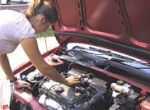


The driving test was initially introduced in the United Kingdom in 1935.
During the intervening years several amendments have been made to the
test to keep it up-to-date and make it relevant to producing drivers
capable of being safe road users in the 21st century. The driving test
is straightforward and has been designed to see if you are able to
demonstrate consistent safe driving observing the Highway Code.
What's Involved?
The test will last about 40 minutes and consists of three parts:
Eyesight Check
The test starts with an eyesight check (if you fail this,
your test will not continue). The eyesight test requires you to read
a number plate that is a certain distance away. The distance
requirement for the old-style number plate is 20.5 metres (about 67
feet) and 20 metres (about 66 feet) for the new-style number plate.
New-style number plates were introduced on 1 September, 2001 and are
easily identifiable because they start with two letters ie AB51 ABC.
Vehicle Safety Checks
After the eyesight test you will be asked one of the vehicle safety
check questions, often referred to as "Show Me/Tell Me" questions.
These are basic safety checks that a driver should carry out to
ensure the vehicle is safe for use. Although some checks
may involve the candidate in opening the bonnet to identify where
fluid levels would be checked, pupils will not be asked to touch a
hot engine or physically check fluid levels. As vehicle technology
advances, more and more vehicles are being equipped with electronic
diagnostic systems, which inform the driver of the state of the
engine fluid levels and tyre pressures. It will be acceptable for a
candidate to refer to the vehicle information system (if fitted)
when answering questions on fluid levels or tyre pressures. You will
be asked a second question whilst on the move. One or both
questions answered incorrectly will result in one driving fault
being recorded.
some checks
may involve the candidate in opening the bonnet to identify where
fluid levels would be checked, pupils will not be asked to touch a
hot engine or physically check fluid levels. As vehicle technology
advances, more and more vehicles are being equipped with electronic
diagnostic systems, which inform the driver of the state of the
engine fluid levels and tyre pressures. It will be acceptable for a
candidate to refer to the vehicle information system (if fitted)
when answering questions on fluid levels or tyre pressures. You will
be asked a second question whilst on the move. One or both
questions answered incorrectly will result in one driving fault
being recorded.
Driving Ability
During the driving test the Examiner will give you directions which
you should follow, and for around 20 minutes you will be asked to
drive independently, following either road signs or using a sat nav. Test routes are designed to be as uniform as
possible and will include a range of typical road and traffic
conditions. During the test, the Examiner will ask you to carry out
set exercises incorporating one of the following reversing
manoeuvres:
You may also be asked to carry out an emergency stop exercise.
You can make up to 15 driving faults and still pass the test (16 or more will result in failure).
However, if you commit one serious or dangerous fault you will  fail the test. If at any time your
Examiner considers you to be a danger to other road users your test will be stopped.
fail the test. If at any time your
Examiner considers you to be a danger to other road users your test will be stopped.
At the End of the Test
When the driving test is over, the Examiner will tell you
whether you passed or failed. You can request feedback on your
test from the Examiner, who will then go through your
performance during the test. You can invite your instructor to
attend this debrief if you wish.